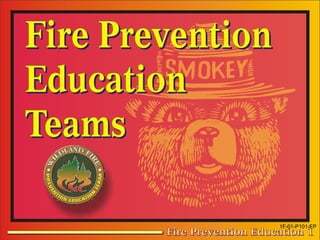
P 101 ep 1-f
- 2. Objective Explain the roles, mobilization, and utilization of Fire Prevention Education Teams. 1F-02-P101-EP
- 3. Introduction Change is always constant. Just the fact that there are more people in the world each day means that the potential for careless or accidental wildfire increases. 1F-03-P101-EP
- 4. Introduction When you combine this fact with the number of communities popping up near the wildlands, the only thing that will reduce loss are those actions taken before the fire burns. Fire Prevention Education Teams offer a new aspect to this wildfire scenario. 1F-04-P101-EP
- 6. The Story • Fire Season – 1996, Southwestern Geographic Area of the US • Department Of Interior Diagnostic Team • National Park Service funded first team activity 1F-06-P101-EP
- 7. • Teams activated across the geographic area • Evaluation Panel – Successful effort • Plan developed to implement National Program 1F-07-P101-EP
- 8. • 1997 National training programs began for Team Members and Team Leaders • 2002 – NWCG approves multi-year Implementation Plan • Wildland Fire Education Working Team provides oversight 1F-08-P101-EP
- 9. • NWCG Training courses developed – P-310, Fire Prevention Education Team Member – P-410, Fire Prevention Education Team Leader 1F-09-P101-EP
- 10. 1F-10-P101-EP
- 11. Historical Use Patterns • Activation expectation – 22 Teams • Activation history - April-November • 70 percent - July-August • Activation – 76 percent Forest Service + BLM, BIA, States, FEMA • Core team consists of three 1F-11-P101-EP
- 12. 1F-12-P101-EP
- 13. • Training complete – 100+ Team Leaders – 420+ Team Members, Public Affairs, and PIO 1 and 2 – Geographic Area Fire Prevention Coordinators – FS National Fire Prevention Branch Director 1F-13-P101-EP
- 14. 17-14-P101-EP
- 15. • Position Codes – PETL – Fire Prevention Education Team Leader – PETM – Fire Prevention Education Team Member – PREV – Fire Prevention Specialist • 310-1, Revised • FSH 5109.17 Revised 1F-15-P101-EP
- 16. When should Fire Prevention Education Teams Be Used? 1F-16-P101-EP
- 17. Severity Conditions 1F-17-P101-EP
- 18. Catastrophic Fire Events 1F-18-P101-EP
- 19. Multiple Fire Occurrence 1F-19-P101-EP
- 20. Increased Risk Management 1F-20-P101-EP
- 21. Severe Fire Conditions Natural Disasters 1F-21-P101-EP
- 22. What Are Teams Expected To Do? 1F-22-P101-EP
- 23. Public Education 1F-23-P101- EP
- 24. Community Protection-Planning 1F-24-P101-EP
- 25. Campaign Development 1F-25-P101-EP
- 26. Mass Media 1F-26-P101-EP
- 27. Public Awareness 1F-27-P101-EP
- 28. Establishing Cooperatives and Partnerships 1F-28-P101-EP
- 29. Fire Prevention Education Team Configuration 1F-29-P101-EP
- 30. The Minimum Mobilization: • One PETL – Fire Prevention Education Team Leader • One PETM – Fire Prevention Education Team Member • PIO – Type 1 or 2, or Public Affairs 1F-30-P101-EP
- 31. Additional Positions: • PETL – Fire Prevention Education Team Leader – Trainee • PREV – Fire Prevention Technician 1F-31-P101-EP
- 32. Additional Positions: • Actual team composition will be determined by the team leader and ordering unit on a case-by-case basis, to be determined by the needs of the assignment. 1F-32-P101-EP
- 33. FPET Rotation Process • FEPTs will be on a maximum 14-day rotation • FPETs have a 72-hour call status and will remain in this status for 14 days. 1F-33-P101-EP
- 34. • GACCs with more than one FPET may decide which team responds to the National call. • GACCs should commit all internal teams before placing requests to NICC. 1F-34-P101-EP
- 35. • If NICC receives a request, the first available team in the scheduled rotation will be ordered. • The rotation will change on alternate Tuesdays, at 2400 Mountain time. 1F-35-P101-EP
- 36. Participating Geographic Areas • Northern Rockies • Pacific Southwest • Rocky Mountain • Northwest • Southwest • Southern • Eastern Great • Eastern Basin 1F-36-P101-EP
- 37. Demobilization • Fire Prevention Education Teams will be released through established ordering channels 1F-37-P101-EP
- 38. Fire Prevention Education Teams “An Ounce of Prevention” 1F-38-P101-EP
- 39. Summary and Review Lesson Objective Explain the Roles, Mobilization, and Utilization of Fire Prevention Education Teams 1F-39-P101-EP
